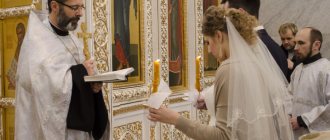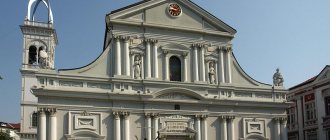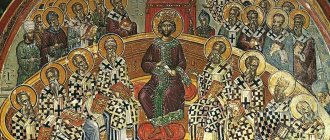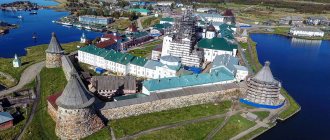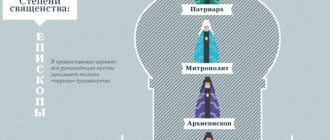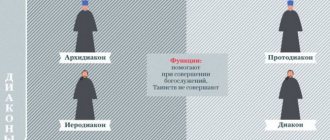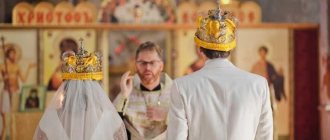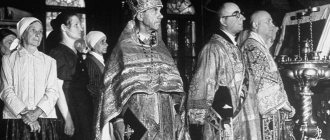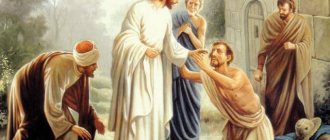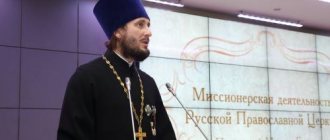What is holiness
Modern theological encyclopedias call it “one of the fundamental concepts of Christian teaching ,” although the Gospel speaks of the holiness of God, His Son Jesus, and finally the Spirit, the Third Person of the Holy Trinity. But not people. But the disciples of Christ talk a lot about this - already after the birth of the Church.
Definition
The content of the concept is not the same among Jews and Christians.
"Holy" or "righteous"?
The Slavic "holiness", the Greek "αγιότητα" ( "hagiotita ") or "ιερότητα" ( "hierotita ") are all almost literal translations of the Hebrew word "kadosh", which applies only to God, the Divine, or that which is dedicated to Him ( for example, sacrifices, temples, liturgical vessels). “ Kadosh ” means separation from the human world, separation from it.
For this reason alone, a Jew would never use this word to designate a person, although God Himself speaks more than once about holiness as the task of believers:
"Be Holy For I Am Holy"
(Lev.1:44).
But still, for a person who was especially close to God, the concept of “righteous person” . The way to achieve perfection was to fulfill the Law (and it contains more than 600 commandments, from moral ones to those related to worship, lifestyle, food, clothing, and housing).
Therefore, the Jewish righteous man, the one who knows, observes what the prophet commanded. Moses . So the Jews were not embarrassed to call St. “righteous.” James, the brother of the Lord, the first bishop of Jerusalem, but they were extremely shocked by the violation of the Sabbath by Christ, and especially by the words and actions of St. Paul, “a Pharisee, the son of a Pharisee,” who openly said that he considered everything (and many prohibitions imposed on the believer by the Law!) “to be loss for the excellency of the knowledge of Christ Jesus” (Phil. 3:8). Holiness, direct communication with God was considered an unattainable goal, a matter perhaps of the very distant future, when the Messiah comes.
The concept of holiness in Christianity
The position of Christians, who knew from experience, was different: what the Jews expected had happened, the Messiah, the True God and Man, had appeared to the world. When the economy of human salvation was completed, after the Resurrection, the Ascension of Christ, the Descent of the Holy Spirit, boldness appears in the sermons of the Apostles:
- “a chosen race, a royal priesthood, a holy nation, a people taken as an inheritance...” (this is what Apostle Peter called Christians);
- “children of God” (St. John the Theologian);
- “beloved of God, acknowledged saints,” “saints in Christ Jesus” (Apostle Paul).
In contrast to the current practice of calling “saint” only a deceased Christian who is already standing before God, the Apostles call this the believers who are still among the world. Why?
Because holiness is a person’s participation in God Himself, his internal change, which is given by God’s grace.
Links
- [rus-icons.narod.ru/part17/part172/saint.html Classification of saints]
| Faces of holiness in Orthodoxy |
| Apostle | Unmercenary | Blessed | Blessed | Godfather | Great Martyr | Confessor | Martyr | Righteous | Forefather | Venerable Martyr | Reverend | Reverend Confessor | Prophet | Equal to the Apostles | Saint | Priest Confessor | Hieromartyr | Stylite | Passion-bearer | Miracle Worker | Holy Fool |
Saints and shrines
The holiness of a person is not “kadosh” as separation from the world - on the contrary, a Christian actively lives among it, transforming the life around him thanks to God working through him. Why is this possible? Yes, because God Himself became a man, destroying His separation from the world of people. He who entrusts himself to Him receives the opportunity to be deified - that is, to become a “child of God.”
However, along with this new understanding of holiness, Christians also retained elements of the Old Testament understanding - like the Jews, they call “saints”:
- God;
- temple, liturgical objects;
- other places of God’s special presence, there is the concept of “holy places”;
- The Church, as created by God, having the grace of the Spirit.
Road to Heaven
It is about holiness-perfection that Jesus Christ as the task of man, commanding him to love everyone, “that you may be sons of your Father in heaven, for He makes His sun to rise on the evil and on the good, and sends rain on the just and the unjust” (Matthew 5: 44). Such spiritual heights are possible, of course, with God’s help. Therefore, connecting with Him is both a task and... a path to achieving it.
St. Silouan of Athos says this: “ Grace made me know that all people who love God and keep His commandments are full of light and like the Lord, and those who go against God are full of darkness and like the enemy.”
From the lives of saints, examples of such, “like the Lord” people are known. Yes, Rev. Paisius the Great tearfully begged Christ to have mercy on his disciple who had renounced the faith. Finally, the Lord Himself appeared to him with the words:
“Paisios, for whom are you praying? Has he denied Me? But the monk continued to beg. Then Christ said: “O Paisius! You have become like Me in love!”
By what criteria are they considered saints?
Over time, the Church began to understand how saints, Christians who especially pleased God, and also perform a conciliar prayer for them, bless believers and turn to these saints of God for support. This is the meaning of the church glorification of a person as a saint.
The reasons for it now are:
- righteous Christian life, lifetime miracles;
- posthumous miracles, duly attested;
- popular veneration based on the signs being performed.
In addition, manifestations of holiness can be;
- great services to the Church;
- martyrdom for faith;
- incorruption of the relics.
The relics of St. Alexander Svirsky in the Holy Trinity Alexander-Svirsky Monastery of the Tikhvin Diocese of the Russian Orthodox Church, located in the village of Staraya Sloboda, Lodeynopolsky district, Leningrad region, on the shore of Lake Roshchinskoye.
Some of the listed grounds may be absent when canonizing a particular saint, for example:
- perhaps little is known about his worldly life, or the “human judgment” about it is rather negative (examples - right. Simeon of Verkhoturye , at the time of the appearance of whose relics no one even remembered his name; right. youth Artemy Verkolsky , killed by lightning, which was considered a sign of a person’s dislike - so much so that he was not even given a Christian burial);
- very often the relics of a saint are not found, or are destroyed, or have been subjected to decay, and are “in the bones.”
Interesting fact
The incorruption of relics in itself is not a basis for canonization at all, if there are no other criteria, especially evidence of miracles. Moreover, for example, according to the tradition of St. Mount Athos is precisely the incorruption of the remains of a deceased monk - grounds for believing that he lived an unpleasing life; it is necessary to pray for him.
Thus, with each canonization, the issue is resolved taking into account the specific circumstances of the ascetic’s life and his veneration. But a prerequisite for glorification as a saint is posthumous miracles through prayers to him.
Right John of Kronstadt with his wife. Fragment of a photograph by K. Bulla. Beginning XX century (Central State Archive of Film and Photo Documents of St. Petersburg)
There is also no formally established period for the death of an ascetic, after which the issue of his glorification can be considered. Decades, even centuries may pass (for example, Blessed Xenia of Petersburg was glorified approximately 300 years after her death, right. John of Kronstadt a little less than 100 years later).
And some saints of God are glorified by the Church much earlier: for example, St. Paisius the Svyatogorets died in 1994, and was glorified as a saint on January 13, 2015 (since May 5 of the same year, his name has been in the Saints of the Russian Church).
Notes
- This “naming is sometimes used in relation to a saint or non-canonized ascetic of piety (regardless of his holiness or type of feat) as an adjective with the meaning “who has acquired the gospel beatitudes,” “living according to the commandments of the gospel beatitudes”” - op. stat. Blessed One // Orthodox Encyclopedia.
- [www.pravenc.ru/text/149361.html Blessed // Orthodox Encyclopedia.]
- In liturgical texts the name passion-bearer
in relation specifically to martyrs for the faith.
Orders of holiness in Orthodoxy
The first revered saints of God appeared already in the 1st century. from the Nativity of Christ. The glorification of new saints continues even to this day.
Faces of holiness: list with description
In Orthodoxy, they are most often numbered 9 - just as it is traditionally believed that there are the same number of Angelic faces After all, saints are like earthly Angels. There are also epithets that are attached to this or that saint due to the characteristics of his feat.
- The apostles are the closest disciples of Christ, among whom the saints are considered the supreme ones. Peter and Pavel.
- Adjacent to this rank is the rank of saints equal to the apostles - those who, like the first preachers of Christ, also worked to spread the faith. For example, this is how St. Olga , Prince Vladimir - in Russia, Byzantine Emperor Constantine the Great.
- Reverends are monastic saints of God. In addition to the rank, sometimes a designation of his feat is added to the name of such a saint: “stylite”, “recluse”, “obedient”, others.
- Prophets. The Saints count 19 - 18 of the Old Testament, who heralded the coming of Christ, one of the New Testament, St. John the Baptist.
- Those without silver are those who carried out the feat of free service to people. Often these are doctors and healers. For example, “unmercenaries” have been called since centuries. Cosmas and Damian.
- The faithful are rulers glorified by the feat of faith. There are especially many of these among Russian saints. princes Boris and Gleb, are glorified as faithful (at the same time - passion-bearers)
- Martyrs are those who accepted suffering for Christ. Among these saints of God, the church singles out the great martyrs who suffered especially. In addition, those who have accepted suffering in modern times are called new martyrs . And the sufferers whom the Lord honored with a peaceful death after all the torment are called confessors. If a martyr or confessor bore the holy, monastic rank, he is called a holy martyr, pre-martyr, or a holy confessor, a venerable confessor.
- The righteous are the laity who carried out the Christian feat, including lay priests. St. is glorified as “righteous. ” John of Kronstadt . The Fathers of God, the parents of the Most Holy Theotokos , St. Joachim and Anna.
- The blessed are saints of the most difficult feat, who have taken upon themselves imaginary madness, foolishness (the word comes from the Slavic “freak”, literally meaning “fool”). Blessed are also sometimes called those saints who did not accept such a feat, but for whom, according to tradition, this name was assigned. For example, these are the Western fathers from centuries. Jerome of Stridontsky, Augustine . The tradition of naming them this way developed in the West even after the schism of churches (1054).
Holy Fools
- this is the name of the new order of holiness, which has been included in the Russian Church since the beginning of the 14th century. “For Christ’s sake, a holy fool” or “blessed” is a person who has taken on the guise of madness for the sake of rejecting the values of worldly life. With their feat of feigned madness or immorality, they revealed the incompatibility of such concepts as Christian truth and common sense. Almost all holy fools are credited with the gift of prophecy, which is given to them as a reward for their contempt for human reason. According to contemporaries, the ancient Russian holy fools walked naked, with loose hair and an iron chain around their necks. Novgorod became the birthplace of Russian foolishness. It was from Novgorod that Procopius of Ustyug (14th century), Nikola Kochanov (14th century), and Mikhail Klopsky (15th century) came from. The series of Moscow holy fools begins with St. Maxim (15th century), and the most famous among them was St. Basil the Blessed (16th century). In the 16th century Foolishness became a form of prophetic (in the Hebrew sense) service, combined with extreme asceticism and ridicule of the world. In this era, when the church hierarchy found itself practically deprived of its right to mourn (intercession) for those unjustly convicted, the feat of holy fools acquired social and even political meaning: denunciation of the powerful of this world became an integral part of holy foolishness. It is the holy fool, who cannot be deprived of his voice, who now acts as the only champion of Christ’s truth. From the end of the 16th century. The authorities are beginning to become increasingly suspicious of holy fools. In the 18th century The Synod prohibited the canonization of the blessed. The last saints of this order of holiness were Blessed Xenia of St. Petersburg (18th–19th centuries) and Blessed Nikolai Rynin (19th century), canonized in the 20th century.
Halo - a symbol of holiness on the icon
This is the radiance around the head of the saint, which is written on the icon. It means the Grace of God given to him. The tradition of depicting a halo has Old Testament origins: according to the Bible, from the face of the prophet. Moses, to whom God spoke, had such a radiance that he had to cover it with a cloth (Ex. 34:29).
“When Moses came down from Mount Sinai, and the two tablets of the testimony were in Moses’ hand as he descended from the mountain, Moses did not know that his face began to shine with rays because God spoke to him” Exodus 34:29
How to achieve holiness
Many beginners, having read the description of the extraordinary feats of the saints, think that their repetition is the true path to holiness.
Experienced confessors, however, warn against such jealousy, pointing out that forty-day fasts with complete abstinence from food, night vigils on a pillar, and other similar feats are not the path to holiness, but... already its manifestations.
The very road that the saints of God walked is usually not described by the authors of their lives. In some way, the veil of mystery is lifted by publications about saints almost contemporary to us. An example of this is the beloved shepherd, right. John of Kronstadt:
- his canonical life describes the miracles of the great father, his zeal for worship, inspired sermons;
- Along with him there is his own spiritual diary; more or less complete editions of it have been carried out in recent years; this is the saints’ daily denunciation of themselves for their failures, their coldness towards their neighbors - and this is not false humility, he writes, as they say, with facts in hand;
- finally, there are studies of the saint’s life, according to which he had to endure a lot from his co-servants of the cathedral (a young priest burning with faith, for example, performed free services for the poor), from his wife (he decided to live with her as brother and sister, and not as wife), her relatives, whom he, according to the marriage contract, had to support with his salary (and he gave it to the poor!). This is precisely the world's usual reaction to holiness.
It is clear that under such conditions it is easy (and even, humanly speaking, excusable!) to lose one’s emotions and say a harsh word...
Is admitting one's sinfulness the beginning of holiness?
But the saint differs from the “ordinary person” in that he humbles himself and does not complain. Yes, not right away. Yes, through falls. They are, in fact, described by St. John. The path of humility is difficult, full of sorrows, which sometimes seem to be beyond measure. But having gone through them, a person confesses his weakness, recognizes himself as a sinner, and not a “great ascetic.” This is how you can make room for God’s grace.
St. John Climacus wrote:
“I did not fast, nor did I lie down, nor did I lie down on the ground; But I humbled myself, and the Lord saved me.”
It’s very simple, even, they say, joyful. And also incredibly difficult.
What is uncleanness and defilement in Orthodoxy
Orthodoxy recognizes what was accepted back in the time of the prophet. Moses, the so-called “ritual impurity”, which makes it impossible, for example, to accept the Sacraments. For example, a Christian woman will not start them during the “monthly cleansing.”
But still, real defilement is much more serious than external impurity. This is “spiritual dirt”: thoughts, sinful deeds, the general state of the soul that distances it from God. It is towards this that the spiritual struggle of the believer is directed, coupled with falls, after which it is necessary to get up and move on - even if you seem hopeless to yourself. Whether a person is holy or not is up to the Lord, who said:
“Whatever I find, that’s what I’ll judge.”
Natalia Sazonova
Excerpt characterizing the Face of Holiness
- Yes, how to get married! - Pierre said in response to Marya Dmitrievna’s words. - He couldn’t get married: he’s married. “It’s not getting any easier hour by hour,” said Marya Dmitrievna. - Good boy! That's a bastard! And she waits, she waits for the second day. At least he will stop waiting, I must tell her. Having learned from Pierre the details of Anatole's marriage, pouring out her anger on him with abusive words, Marya Dmitrievna told him what she had called him for. Marya Dmitrievna was afraid that the count or Bolkonsky, who could arrive at any moment, having learned the matter that she intended to hide from them, would challenge Kuragin to a duel, and therefore asked him to order his brother-in-law on her behalf to leave Moscow and not dare show himself to her on the eyes. Pierre promised her to fulfill her wish, only now realizing the danger that threatened the old count, Nikolai, and Prince Andrei. Having briefly and precisely stated her requirements to him, she released him into the living room. - Look, the count doesn’t know anything. “You act like you don’t know anything,” she told him. - And I’ll go tell her that there’s nothing to wait for! “Yes, stay for dinner if you want,” Marya Dmitrievna shouted to Pierre. Pierre met the old count. He was confused and upset. That morning Natasha told him that she had refused Bolkonsky. “Trouble, trouble, mon cher,” he said to Pierre, “trouble with these motherless girls; I'm so anxious that I came. I'll be honest with you. We heard that she refused the groom without asking anyone anything. Let’s face it, I was never very happy about this marriage. Let's say he is a good person, but well, against his father's will there would be no happiness, and Natasha will not be left without suitors. Yes, after all, this has been going on for a long time, and how can it be without a father, without a mother, such a step! And now she’s sick, and God knows what! It’s bad, Count, it’s bad with daughters without a mother... - Pierre saw that the Count was very upset, he tried to shift the conversation to another subject, but the Count again returned to his grief. Sonya entered the living room with a worried face. – Natasha is not entirely healthy; she is in her room and would like to see you. Marya Dmitrievna is with her and asks you too. “But you are very friendly with Bolkonsky, he probably wants to convey something,” said the count. - Oh, my God, my God! How good everything was! - And taking hold of the sparse temples of his gray hair, the count left the room. Marya Dmitrievna announced to Natasha that Anatol was married. Natasha did not want to believe her and demanded confirmation of this from Pierre himself. Sonya told Pierre this as she escorted him through the corridor to Natasha’s room. Natasha, pale, stern, sat next to Marya Dmitrievna and from the very door met Pierre with a feverishly shining, questioning gaze. She did not smile, did not nod her head to him, she just looked stubbornly at him, and her gaze asked him only about whether he was a friend or an enemy like everyone else in relation to Anatole. Pierre himself obviously did not exist for her. “He knows everything,” said Marya Dmitrievna, pointing at Pierre and turning to Natasha. “Let him tell you whether I was telling the truth.” Natasha, like a shot, hunted animal looking at the approaching dogs and hunters, looked first at one and then at the other. “Natalya Ilyinichna,” Pierre began, lowering his eyes and feeling a feeling of pity for her and disgust for the operation that he had to perform, “whether it’s true or not, it should be all the same to you, because...” “So it’s not It's true that he is married! - No, its true. – Was he married for a long time? - she asked, - honestly? Pierre gave her his word of honor. – Is he still here? – she asked quickly. - Yes, I saw him just now. She was obviously unable to speak and made signs with her hands to leave her. Pierre did not stay for dinner, but immediately left the room and left. He went around the city to look for Anatoly Kuragin, at the thought of whom all the blood now rushed to his heart and he had difficulty catching his breath. In the mountains, among the gypsies, among the Comoneno, it was not there. Pierre went to the club. In the club everything went on as usual: the guests who had come to dine sat in groups and greeted Pierre and talked about city news. The footman, having greeted him, reported to him, knowing his acquaintance and habits, that a place had been left for him in the small dining room, that Prince Mikhail Zakharych was in the library, and Pavel Timofeich had not arrived yet. One of Pierre's acquaintances, between talking about the weather, asked him if he had heard about Kuragin's kidnapping of Rostova, which they talk about in the city, is it true? Pierre laughed and said that this was nonsense, because he was now only from the Rostovs. He asked everyone about Anatole; one told him that he had not come yet, the other that he would dine today. It was strange for Pierre to look at this calm, indifferent crowd of people who did not know what was going on in his soul. He walked around the hall, waited until everyone had arrived, and without waiting for Anatole, he did not have lunch and went home.
